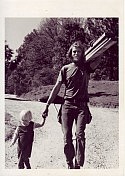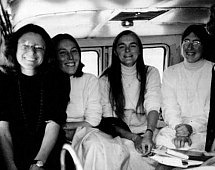Families
While some families had arrived as early as 1969, they began to come in greater numbers in 1971 and thereafter. Life for anyone at Ananda was difficult on the material plane for families it sometimes proved impossible. As there was little or no infrastructure
at first, this meant that homes still were cabins with no running water or electricity. Yet, families were drawn to Ananda because of spiritual ideals just as were single people. These first, dedicated souls worked together to provide a foundation for spiritual family life, and over the years families have helped develop How to Live Education that addresses the needs of the whole child, not only his or her academic life. As families continued to join the community their particular challenge was to build a life of inner renunciation while attending to the responsibilities of family life. It should be noted that of Yogananda’s first disciples, nearly all were married or widowed. From our line of masters, both Lahiri Mahasaya and Sri Yukteswar were married. When Lahiri Mahasaya received Kriya Yoga from Babaji, he specifically asked that the technique be available to all sincere seekers, not only to monastics. Babaji’s answer was, “Be it so. The divine wish has been expressed through you.” (From Chapter 34 of Autobiography of a Yogi) Most families lived at the Farm/Village, where for single people and families alike, there
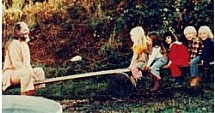
Swami visits the preschool
seemed to be great difficulty in establishing a regular schedule of group sadhana (spiritual practices). Added to that was the difficulty of finding a harmonious way to include children in ones sadhana; the challenge often proved to be too much for a family. Along with this, the need to provide food and shelter often competed with the ashram schedule. The first Ananda families drew on their creative energy to develop spiritual family life.
Early Family life at Ananda Contributed by Lakshmi (Suzanne) Selbie
My first child, Gyani, was born in 1973 in an unfinished dome at the Meditation Retreat, with no running water, a leaky roof, and a wood stove which didnt work very well. In spite of the hardships, though, I loved being there in the woods seeking realization and living with fellow seekers. As many of my friends had become nuns and monks the previous year, it felt awkward to be a parent in a monastic community, but people were kind and accepting even though there were no precedents for how to do this.
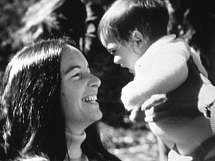
lakshmi and gyani (michelle)
Meditation got harder and less frequent with a baby. For a while I took her to satsangs and even on long trips with Swami and other assistants, where Gyani and I bunked down on the floor together as guests in peoples homes, as Swami gave talks and made recordings. When Gyani was six or seven months old we moved to the farm into a cozier house (a tiny log cabin, carpeted everywhere with red carpeting!). With no car for much of this time, I walked to the Publications building carrying Gyani and put her in a playpen while I did clerical work. When she got heavier and more mobile, and working at Publications was no longer possible, she and I would go to the Reception Center and greet visitors. I gave tours of the community on foot, with Gyani on my hip. Being a single mother was stressful and difficult, but it never occurred to me to be anywhere else. It was a joy to be there. Later, spiritual life grew harder because I couldnt take Gyani to satsangs (spiritual gatherings) and there were many lonely times, but I still managed to have kirtans (chanting sessions) at my house. Haridas and others gathered at my house to do Yogananda’s Affirmations for Psychological Success. We called ourselves the Future Saints Club. As time went on families began to learn how to live this family/monastic life.
Simple Living Contributed by Vidura and Durga (John and Sally Smallen)
We had looked all over the state of California for a place to live: a place with high ideals, yogic principles, schools our two children could attend, and like minded people where we could learn and grow. Did such a place exist? We just couldnt find one we felt in tune
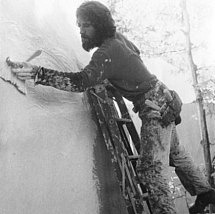
Vidura resurfacing temple
with although we met many people who wanted something more than the typical lifestyle known to us at the time. Then we attended a Meeting of the Ways conference in San Francisco, where we met Swami Kriyananda and people from Ananda community in Nevada City, only four hours from where we lived! From the time we first visited Ananda with its 80 some members, we felt at home, and we moved there four months later after finishing up our jobs, homelife, and schools in Oakland. We spent the first 3 months in a tent and served anywhere we were needed: Vidura on top of the domes at the retreat, applying much needed mastic to keep the rain out; Durga helping in the office. The children attended camp and read the Autobiography of a Yogi for the first time. We all felt very comfortable here and began our new life. One of the most delightful images we have from those early days is of our daughter, Melissa, taking off riding on her horse Britches when she was just ten years old. She
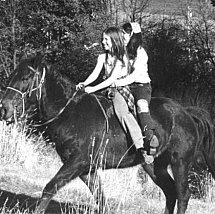
Melissa and friend on Britches
would come home from the small 12-student Ananda School, do her chores, and then bridle her horse, sometimes with saddle, sometimes bareback, and take off down the dirt roads to her friends homes. Life was simpler then: no phones or electricity, not many cars, no thought of being afraid in the woods. Our day was regulated pretty much by the sunlight hours. The only real phone was at the Publications Building. Life was slower and yet we all worked hard. Evenings without electricity were quiet and we often spent them playing board games or reading to one another. TV was not an option, and video was not yet invented. Propane and gas lights were usually out by 9:00 PM. Swamiji was often here giving classes on the weekends and helping us with much needed personal advice whenever we asked for it. The simplicity and joy were tangible. It was 1974 — and we were beginning to grow as a community.
Marriages
Marriage can be a foundation for the spiritual life. Through the friendship that is grown and nurtured in a marriage environment, we find support in our spiritual efforts. At Ananda, we have sought to refine marriage to fit the realities of contemporary society while keeping spiritual ideals alive. As in society in general, not all our marriages have succeeded, but those couples that have parted have, with rare exception, remained friends. These marriages at took place at Ananda in the early years:
- Sadhana Devi and Jaya Helin – 1973
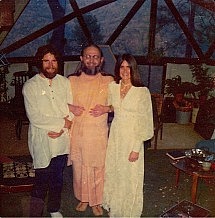
wedding durga and vidura 1974
- Durga and Vidura Smallen – 1974
- Devi and Jyotish Novak – 1975
- Shivani and Arjuna Lucki – 1975
- Saraswati and Ganesha Kieran – 1976
Renunciation
After the Retreat season of 1971 ended with the third annual Spiritual Renewal Week, Kriyananda held a meeting of single people to ascertain whether there was interest in a monastic order. Several people attended, and later that month seven people took conditional monastic vows. They were: Satya, Jaya, Binay, Haridas, Seva, Shivani, and Sadhana Devi. The order was called The Friends of God. It was a life changing experience for us. Kriyananda didn’t speak of the things one was giving up; instead he focused on a life lived dedicated to God, and explained that the heart of renunciation is about what we embrace — God. To the degree that we can embrace this life we will find harmony.
From Jaya’s talk at Spiritual Renewal Week 2005
“From that moment forward, my life totally changed. I became a different person. I began to understand what it was to be a devotee on the spiritual path. All seven of us were changed and each one of us is still here.”
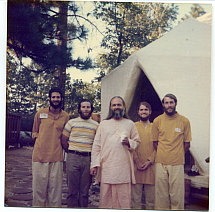
Prahlad, Haridas, Swami, Keshava, Santosh
In a newsletter of April 1972, Kriyananda said, “There can be no spiritual progress without at least some spirit of renunciation. In a community such as ours this spirit is especially important. I want this, I want that is a thought that must be replaced by, What is right? or What is best for everyone?, or best of all, What does God want? What does Guru want? That is the only way to develop harmoniously as a group, and it is the only way for individuals to develop themselves, spiritually.” (Banyan Tree, 1972) In 1971 Kriyananda spent the summer living in a tent on a piece of property that he had purchased very near to the Farm. His friend Phil Capy had had a dream in which the Master told him to help Kriyananda build his dome home. Phil had begun construction in the early part of the year and by the fall it was nearly completed. At about the time that Kriyananda moved into his new dome the new renunciates moved their tepees and trailers to the same property, called Ayodhya, after the ancient land of Lord Rama in the Ramayana.
The Nuns Contributed by Seva Wiberg
The nuns were very close. We would go to work together, share cars, and sometimes share meals. Each morning, Parvati or Asha (who joined the monastery later) would ring a bell at 6:00 AM to awaken us for sadhana: energization and meditation together. If we didnt respond right away, Parvati would stand outside and ask for a mothers maiden name or other questions until she got a response! The tepee temple had a wood stove, which would give off smoke, but not much heat, which made us wonder why we were trying to keep it together during those cold, dark days. But, over the years we became a powerful group of devotees that helped to instill a sense
of strong dedication, loyalty, and perseverance to the work that was going on all around us. Many of the monks and nuns were leaders who started businesses, organized campaigns, held the finances together, built buildings, and were on the forefront of most activities. It became apparent after many years that to really build a community, however, the families needed to be in charge. This is when the monastic energy was replaced by a group of married renunciates, many of whom had earlier been part of the monastery. This new renunciate order showed that, no matter whether a person was married or single, the dedication to finding God and serving the work was what true renunciation was really all about. By placing a monastery in the midst of the community, the spirit of renunciation began to permeate the community as a whole. Eventually, both single people and married couples began to live a life of inner renunciation. Today, there is a renewal of interest in a monastery, and ten men now comprise the monastery. In addition, there are ten monks at Ananda, India. Of the original seven monastics, all are still active members of Ananda. Five are married; four with children. They, along with all families at Ananda, work to set an example of inner renunciation regardless of outer roles. Today, all members of Ananda are also members of a lay monastic order.
Children and School
Family life is another opportunity in attunement, a chance to figure out, “What would Master do with children? How can you find ways to share the Path and Divine Mother with the kids?” In my experience, it’s more about everyday life. If you’re trying to keep your mind on God and staying centered, the kids pick it up by osmosis. We’ve found that there is no one way to raise kids in a spiritual community. The process is as unique as the individuals themselves. It involves giving everyone the space they need in order to find the pattern that works most harmoniously for them.
Ananda High School
In April, 1970, students from a private school called Pacific High School visited Ananda from the Bay Area, along with two of their teachers. They camped out and woke up to snow and caved-in tents. Their school had geodesic domes and so they offered to spend their summer building another dome for the retreat kitchen. The following year the two teachers, Dharmaraj and Meera (Alan and Heath Schmidt), joined Ananda and created Ananda High School, emphasizing personal creativity and freedom of expression along with spiritual self development. Tuition was $2,970.00 per year, including room and board. This was the beginning of Ananda How to Live Education.
Ananda High School Contributed by Maitri Jones
I was 18 years old when I first came to Ananda. David Phillips, a teenage friend of mine from Seattle, knew that I was interested in yoga and told me about a boarding school where he was going to finish his last year of high school. After writing to the school directors, Dharmaraj and Meera, and also receiving some sweet notes of encouragement from a former student, Kumari, I decided to join David at the Ananda High School. Even though I had already completed a diploma at a public high school, I was convinced that
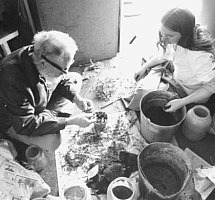
maitri and haanel gardenig
at the Ananda School I could learn far more about who I was and what would bring me happiness than I had in any previous school experiences. At the time the school was the only program being offered at Ananda for someone of my age. Some of the great souls such as Satya, Anandi, Devi, Shivani, Asha, and Haanel turned out to be inspiring guest teachers for my high school classes. True to their promises Dharmaraj and Meera took me into their family of students and introduced me to a way of life that I had longed for. They helped me discover Ananda as a group of joyful and courageous people who were living their lives dedicated to finding God. Ananda High School turned out to be the doorway to finding my guru and spiritual family. Editor’s Note: Maitri later moved to Seattle, completed her education, married, and had two daughters. She and her family later returned to Ananda, and her daughters have both attended Ananda High School.
Elementary School: Drawing out the leaders
In 1971, Nitai (Michael Deranja) visited the Retreat as a student teacher. When he
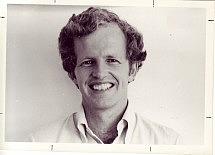
Nitai
received his teaching credential the next year, he returned and began teaching school to the elementary grades, continuing the efforts made in the previous year by another teacher. He tried to put into practice these words of Kriyananda’s: “As a leader, you will get the best results for the least amount of effort if you work with those who are in tune with your ideals. You would be wise not to give a disproportionate amount of energy to those who are not in tune. Creativity cannot thrive where too much effort is devoted to merely holding the line.” (From Chapter 11 of The Art of Supportive Leadership) Although some of the children weren’t interested in school, Nitai followed Kriyananda’s example, and made friends with the children who did seem interested. They, in turn, magnetized the other children and soon there was a class.
Ananda School Contributed by Nitai Deranja
Certainly a big part of my life at Ananda has been focused around the children. I have appreciated the chance to serve in this way, partly because it is the children who make an intentional community more than a monastery! Children tend to keep things lively, joyful and challenging-all big assets to the larger community. After visiting Ananda for a couple of years, I came here to live in the summer of 1972. The community desperately needed a teacher and had hired someone to come out from town a few days per week. When word got out that I was a teacher, I was immediately asked to take over the job — for one thing, it meant the community could save money! I was presented with a falling-down, 10×12 shed in front of what is now Master’s Market to
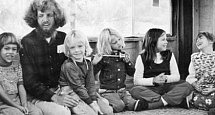
nitai and elementary school
use as the school. Since the shed had been most recently used as a chicken coop, the first job was to shovel out the three foot deep layer of manure. We put plastic over the windows and the walls and installed a very inadequate heater. With no money, desks, or other furniture, it was an extremely humble beginning, but the children didn’t know the difference, and I didn’t mind, so we just dove in and started experimenting. What might spiritual education become? What might Education for Life look like? There were a lot of learning experiences. In those days, the whole community was full of learning experiences which was the code phrase for doing the wrong thing and figuring out later what you should have done! But it was fun. After six months in the shed, we moved into Aspen, one of the first new buildings (along with the publications building) that the community built. It wasnt finished by any stretch of the imagination, but it was a major up-grade from the chicken coop. That first class consisted of seven children, ages four through seven. Storytelling immediately proved to be a popular activity, as well as a fun way of introducing new vocabulary. I began with the story of the Ramayana, telling a little bit of the story every day. One day I told how Hanuman had flown through the sky like a meteor on his way to Sri Lanka. I stopped and asked, “Does anyone know what meteor means?” One boy raised his hand and answered, “A meteor is somebody who eats hamburgers.” Kids can be so cute! Well, I continued the story until I came to the part where Rama was sitting in the forest in samadhi. I stopped and asked, “What does Samadhi mean?” Nicole, four years old, raised her hand and answered, “It’s when you are sitting there really still and someone comes up to you and says, ‘Nicole, Nicole’ and there is nobody there to answer.” So much for children being limited to “cuteness.” It was incidents like this that helped set a tone of mutual respect in our interactions.
Children
These children were born at Ananda, or moved to the community with their parents in the early years:
- Prem Kane (Kalyani Todd)
- Dwayne and Melissa Smallen (Durga and Vidura)
- Michelle (Gyani) Simpson (Lakshmi Selbie)
- Shyama Helin (Sadhana Devi and Jaya)
- Mark (Kalidasa) Novak (Devi and Jyotish)
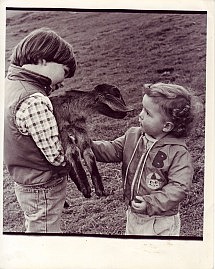
Kalidasa Novak, Nishtan Motyka
Other families with children came to Ananda and attended our schools for a time, later moving on to other schools and interests. Today, some of these grown children are approaching 40 years of age, and include business owners, an herbalist, a machinist, a project manager for a marketing firm, and a primary school teacher. They live all around the world, some of them at our communities, and they often gather at Ananda Village for reunions.
